
Edward de Vere, 17th Earl of Oxford was an English peer and courtier of the Elizabethan era. Oxford was heir to the second oldest earldom in the kingdom, a court favourite for a time, a sought-after patron of the arts, and noted by his contemporaries as a lyric poet and court playwright, but his volatile temperament precluded him from attaining any courtly or governmental responsibility and contributed to the dissipation of his estate.
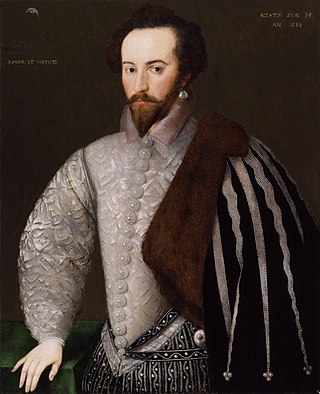
Sir Walter Raleigh was an English statesman, soldier, writer and explorer. One of the most notable figures of the Elizabethan era, he played a leading part in English colonisation of North America, suppressed rebellion in Ireland, helped defend England against the Spanish Armada and held political positions under Elizabeth I.

A Midsummer Night's Dream is a comedy play written by William Shakespeare in about 1595 or 1596. The play is set in Athens, and consists of several subplots that revolve around the marriage of Theseus and Hippolyta. One subplot involves a conflict among four Athenian lovers. Another follows a group of six amateur actors rehearsing the play which they are to perform before the wedding. Both groups find themselves in a forest inhabited by fairies who manipulate the humans and are engaged in their own domestic intrigue. The play is one of Shakespeare's most popular and is widely performed.

The masque was a form of festive courtly entertainment that flourished in 16th- and early 17th-century Europe, though it was developed earlier in Italy, in forms including the intermedio. A masque involved music, dancing, singing and acting, within an elaborate stage design, in which the architectural framing and costumes might be designed by a renowned architect, to present a deferential allegory flattering to the patron. Professional actors and musicians were hired for the speaking and singing parts. Masquers who did not speak or sing were often courtiers: the English queen Anne of Denmark frequently danced with her ladies in masques between 1603 and 1611, and Henry VIII and Charles I of England performed in the masques at their courts. In the tradition of masque, Louis XIV of France danced in ballets at Versailles with music by Jean-Baptiste Lully.

Shakespeare in Love is a 1998 period romantic comedy film directed by John Madden, written by Marc Norman and Tom Stoppard, and produced by Harvey Weinstein. It stars Gwyneth Paltrow, Joseph Fiennes, Geoffrey Rush, Colin Firth, Ben Affleck and Judi Dench.

The Merry Wives of Windsor or Sir John Falstaff and the Merry Wives of Windsor is a comedy by William Shakespeare first published in 1602, though believed to have been written in or before 1597. The Windsor of the play's title is a reference to the town of Windsor, also the location of Windsor Castle in Berkshire, England. Though nominally set in the reign of Henry IV or early in the reign of Henry V, the play makes no pretence to exist outside contemporary Elizabethan-era English middle-class life. It features the character Sir John Falstaff, the fat knight who had previously been featured in Henry IV, Part 1 and Part 2. It has been adapted for the opera at least ten times. The play is one of Shakespeare's lesser-regarded works among literary critics. Tradition has it that The Merry Wives of Windsor was written at the request of Queen Elizabeth I. After watching Henry IV Part I, she asked Shakespeare to write a play depicting Falstaff in love.

John Lyly was an English writer, playwright, courtier, and parliamentarian. He was best known during his lifetime for his two books Euphues: The Anatomy of Wit (1578) and its sequel Euphues and His England (1580), but is perhaps best remembered now for his eight surviving plays, at least six of which were performed before Queen Elizabeth I. Lyly's distinctive and much imitated literary style, named after the title character of his two books, is known as euphuism. He is sometimes grouped with other professional dramatists of the 1580s and 1590s like Christopher Marlowe, Robert Greene, Thomas Nashe, George Peele, and Thomas Lodge, as one of the so-called University Wits. He has been credited by some scholars with writing the first English novel, and as being 'the father of English comedy'.

Twelfth Night, or What You Will is a romantic comedy by William Shakespeare that is believed to have been written around 1601–1602 as a Twelfth Night entertainment for the close of the Christmas season. The play centres on the twins Viola and Sebastian, who are separated in a shipwreck. Viola falls in love with the Duke Orsino, who in turn is in love with Countess Olivia. Upon meeting Viola, Countess Olivia falls in love with her thinking she is a man.

Brabantio is a character in William Shakespeare's Othello. He is a Venetian senator and the father of Desdemona.
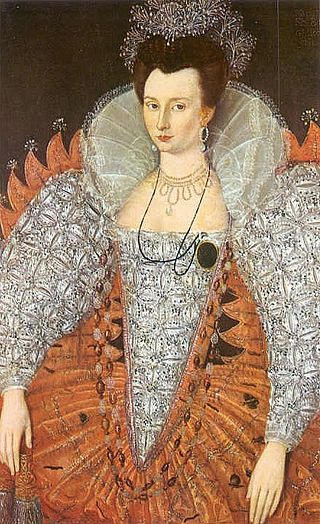
Mary Fitton was an Elizabethan gentlewoman who became a maid of honour to Queen Elizabeth. She is noted for her scandalous affairs with William Herbert, 3rd Earl of Pembroke, Vice-Admiral Sir Richard Leveson, and others. She is considered by some to be the "Dark Lady" of Shakespeare's sonnets.
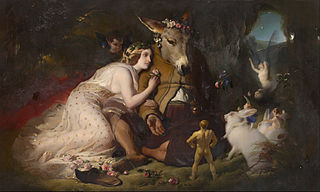
Titania is a character in William Shakespeare's 1595–1596 play A Midsummer Night's Dream.

Alazṓn is one of three stock characters in comedy of the theatre of ancient Greece. He is the opponent of the eirôn. The alazṓn is an impostor that sees himself as greater than he actually is. The senex iratus and the miles gloriosus are two types of alazṓn.
Cynthia's Revels, or The Fountain of Self-Love is a late Elizabethan stage play, a satire written by Ben Jonson. The play was one element in the Poetomachia or War of the Theatres between Jonson and rival playwrights John Marston and Thomas Dekker.
The Witty Fair One is a Caroline era stage play, an early comedy by James Shirley. Critics have cited the play as indicative of the evolution of English comic drama from the humors comedy of Ben Jonson to the Restoration comedy of Wycherley and Congreve, and the comedy of manners that followed.
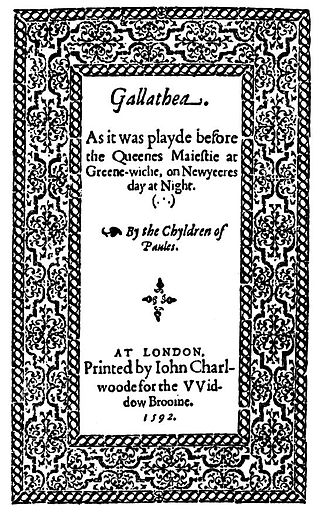
Gallathea or Galatea is an Elizabethan era stage play, a comedy by John Lyly. The first record of the play's performance was at Greenwich Palace on New Year's Day, 1588 where it was performed before Queen Elizabeth I and her court by the Children of St Paul's, a troupe of boy actors. At this point in his literary career, Lyly had already achieved success with his prose romance Euphues and was a writer in residence at Blackfriars theatre. The play is set in a village on the Lincolnshire shore of the Humber estuary and in the neighboring woods. It features a host of characters including Greek deities, nymphs, fairies, and some shepherds.
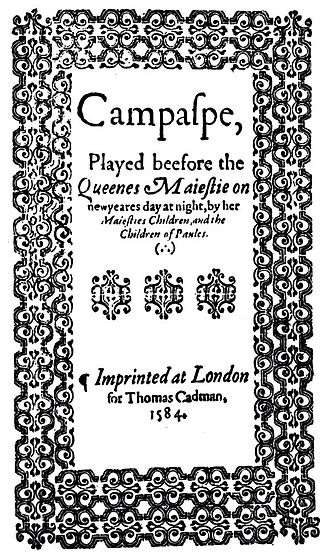
Campaspe is an Elizabethan era stage play, a prose comedy by John Lyly based on the story of the love triangle between Campaspe, a Theban captive, the artist Apelles, and Alexander the Great, who commissioned him to paint her portrait. Widely considered Lyly's earliest drama, Campaspe was an influence and a precedent for much that followed in English Renaissance drama, and was, according to F. S. Boas, "the first of the comedies with which John Lyly inaugurated the golden period of the Elizabethan theatre".
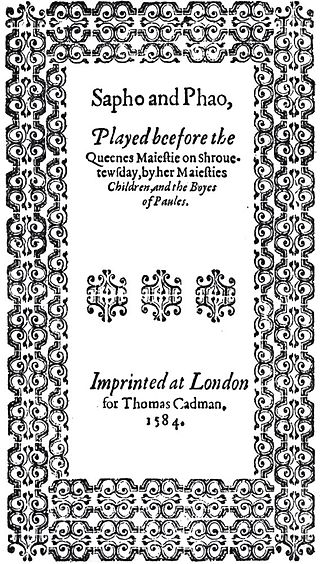
Sapho and Phao is an Elizabethan era stage play, a comedy written by John Lyly. One of Lyly's earliest dramas, it was likely the first that the playwright devoted to the allegorical idealisation of Queen Elizabeth I that became the predominating feature of Lyly's dramatic canon.

Love's Metamorphosis is an Elizabethan era stage play, an allegorical pastoral written by John Lyly. It was the last of his dramas to be printed.
The Thracian Wonder is a stage play of English Renaissance drama, a work that constitutes a long-standing and persistent problem for scholars and historians of the subject.
The Dark Lady is a woman described in Shakespeare's sonnets, and so called because the poems make it clear that she has black wiry hair, and dark, "dun"-coloured skin. The description of the Dark Lady distinguishes itself from the Fair Youth sequence by being overtly sexual. Among these, Sonnet 151 has been characterised as "bawdy" and is used to illustrate the difference between the spiritual love for the Fair Youth and the sexual love for the Dark Lady. The distinction is commonly made in the introduction to modern editions of the sonnets. As with the Fair Youth sequence, there have been many attempts to identify her with a real historical individual. A widely held scholarly opinion, however, is that the "dark lady" is nothing more than a construct of Shakespeare's imagination and art, and any attempt to identify her with a real person is "pointless".
















